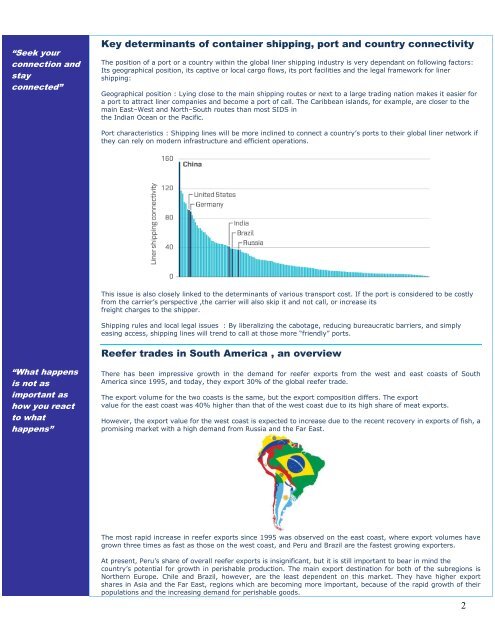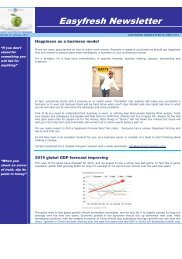Easyfresh Newsletter 07091520.pdf
- No tags were found...
Create successful ePaper yourself
Turn your PDF publications into a flip-book with our unique Google optimized e-Paper software.
“Seek your<br />
connection and<br />
stay<br />
connected”<br />
Key determinants of container shipping, port and country connectivity<br />
The position of a port or a country within the global liner shipping industry is very dependant on following factors:<br />
Its geographical position, its captive or local cargo flows, its port facilities and the legal framework for liner<br />
shipping:<br />
Geographical position : Lying close to the main shipping routes or next to a large trading nation makes it easier for<br />
a port to attract liner companies and become a port of call. The Caribbean islands, for example, are closer to the<br />
main East–West and North–South routes than most SIDS in<br />
the Indian Ocean or the Pacific.<br />
Port characteristics : Shipping lines will be more inclined to connect a country’s ports to their global liner network if<br />
they can rely on modern infrastructure and efficient operations.<br />
This issue is also closely linked to the determinants of various transport cost. If the port is considered to be costly<br />
from the carrier’s perspective ,the carrier will also skip it and not call, or increase its<br />
freight charges to the shipper.<br />
Shipping rules and local legal issues : By liberalizing the cabotage, reducing bureaucratic barriers, and simply<br />
easing access, shipping lines will trend to call at those more “friendly” ports.<br />
Reefer trades in South America , an overview<br />
“What happens<br />
is not as<br />
important as<br />
how you react<br />
to what<br />
happens”<br />
There has been impressive growth in the demand for reefer exports from the west and east coasts of South<br />
America since 1995, and today, they export 30% of the global reefer trade.<br />
The export volume for the two coasts is the same, but the export composition differs. The export<br />
value for the east coast was 40% higher than that of the west coast due to its high share of meat exports.<br />
However, the export value for the west coast is expected to increase due to the recent recovery in exports of fish, a<br />
promising market with a high demand from Russia and the Far East.<br />
The most rapid increase in reefer exports since 1995 was observed on the east coast, where export volumes have<br />
grown three times as fast as those on the west coast, and Peru and Brazil are the fastest growing exporters.<br />
At present, Peru’s share of overall reefer exports is insignificant, but it is still important to bear in mind the<br />
country’s potential for growth in perishable production. The main export destination for both of the subregions is<br />
Northern Europe. Chile and Brazil, however, are the least dependent on this market. They have higher export<br />
shares in Asia and the Far East, regions which are becoming more important, because of the rapid growth of their<br />
populations and the increasing demand for perishable goods.<br />
2









